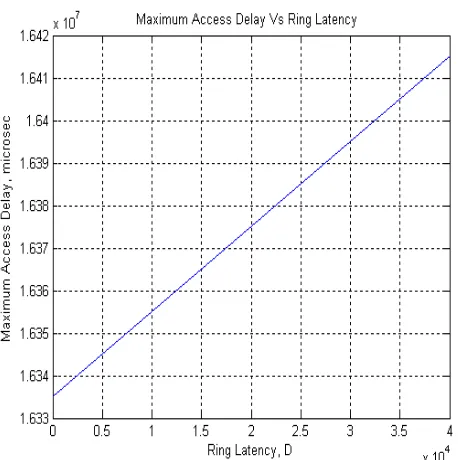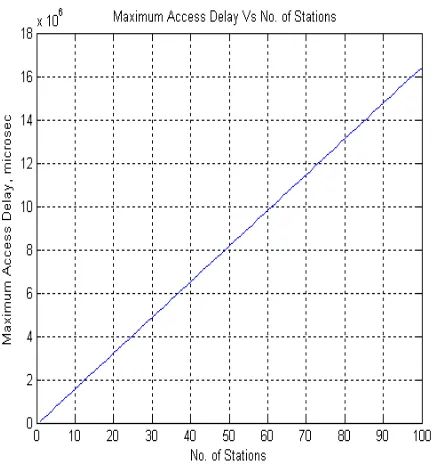Access Delay Optimization In Fddi Networks
Harsimranjot1, S.B.L. Tripathy2, Hardeep Singh Saini3
1. Research Scholar (ECE), Singhania University, Jhunjhunu, Rajasthan-333515, INDIA.
2. Professor &Head of Physics & Electronics Department, Podar Govt. College, Nawalgarh. Jhunjhunu, Rajasthan, INDIA, Contact: +91-9414081831
3. Professor (ECE), Indo Global College of Engineering, Mohali, Punjab-140109, INDIA, Contact: +91-9988016668 Email: jotharsimran@gmail.com, hardeep_saini17@yahoo.co.in
Abstract: FiberDistributedDataInterfaceNetworks was specially designed for use with optical fiber media for peer to peer communications.There are many parameters that influence the performance of the network; network latency, target token rotation time, token holding time, frame size and maximum access delay. The maximum access delay, the time between successive transmission opportunities, is bounded for both synchronous and asynchronous traffic.In our analysis, we set the value of TTRT and optimized the value of access delay. It is concludedthat long delays are not desirable and can be avoided by proper setting of network parameters.
Keywords: Maximum Access Delay; Token Rotation Time; Ring Latency; Efficiency.
1. Introduction
FiberDistributedDataNetworks ( FDDI) allows backbone applications where computers and workstations connected tolocal area networks (LANs) can exchange data with other LANs or LAN segments.[1]. FDDINetworksareintendedto have two datatransmissionpaths whichprovideredundancy. It can be implemented as a higher speedversionofa token ringandisdesignedtoworkoverfiber.It is basically designed
forpeer-to-peercommunicationsbutcancertainlybeusedforthepolled traffic modem.Thebasic principleof thetokenringis thataccesstothe
communicationsringisrestrictedtoonemodematatime: modemtransmits its messagearound the ring. Then, once the messagetravelsentirelyaroundthe ring, the modem removes the data from the ring and passes control (the token) to the next modem in line. This is aneffectiveapproachofdata distributing. There are many parameters that influencethe performance of the network; network latency is the one of the parameter. The main feature in network latency is that, time of transmission between the origin and destination should be instantaneous. Practically, there will always be some delay; even transmission is at very high speed i.e. at speed of light.There are some more factors that contribute to network latency. These include transmission, propagation, routers and computer hardware delays. In network latency, transmission refers to the medium used to transmit the information. This may be a phone line, optical fiber and wireless connection etc. Each will contribute different delay. Some may be faster mediums than other. To reduce latency, faster medium are used. The transition delay can also be decreased by increasing the bandwidth and propagation delay can be decreased by increasing the group velocity. In an FDDI network to improve the efficiency important factor is maximum access delay (MAD).The MAD, the time betweensuccessive transmissionopportunities, is bounded for both synchronous and asynchronous traffic. Although the maximumaccess delay for the synchronoustraffic isshort, thatfor asynchronoustraffic can be long dependingupon the network configurationand load. Unlesscareistaken,the accessdelay canbe as longas 165seconds. Thismeans thatastation wantingtotransmitasynchronoustraffic maynot geta
usable token f o r 165seconds [2]. Such long access delays areclearly not desirableand can beavoided byproper setting ofthe network parametersandconfigurations.
2. Literature Survey:
stability of the asynchronous traffic, for both FDDI and for the new proposed protocol, for which the token rotation time is also bounded by twice TTRT.
3. Optimization ofMaximum Access Delay
A simple model to compute the access delay of the FDDI analytically will now be described. It is assumed that there are n active stations and that each one has enough frames to keep the FDDI fully loaded. FDDI network with a ring latency of D and a TTRT value of T, the Maximum Access Delay (MAD) can be given by equation (i). Assume that all stations are idle until 𝑡 = 𝐷 when the active stations suddenly get a large (infinite) burst of frames to transmit. When station receives the token and resets its Token Rotation Timer (TRT). If it has nothing to transmit, then it forwarded the token to the next station. At time t = D station receives the token. Since it now has an infinite supply of frames to transmit, it captures the token and determines that the TRT (time elapsed since the last time it received the token) is D, and so it can hold the token for the
𝑇𝑇𝑅𝑇 − 𝑇𝑅𝑇 = 𝑇 − 𝐷interval. Station releases the token,
when Token Holding Timer (THT) of station expires.During the cycle, each station waits for an interval of 2𝑇 + 2𝐷 after releasing the token. This interval is the maximum access delay. There are some of the rules which should be followed for the optimization of the performance of FDDI Networks. Main point is, setting the TTRT value, which should be taken into consideration. The token rotation time can be as long as two times the target. On the largest ring, TTRT of 165ms causes a maximum access delay as long as 165 second. So station may have to wait several minutes to receive a usable token. Longer TTRT also results in longer access delay. TTRT limit the access delay. Rings with a large number of stations or smaller extent have a slightly lower efficiency and longer maximum access than those with smaller extents. With the increase in active number of stations efficiency slightly increases but access delay increases.
The maximum size frame on FDDI is 4500 bytes (0.360 ms).
The maximum ring latency is 1.773 ms.
The token time is 0.00088 ms.
No station should request a TTRT less than Tmin.andTTRT more than Tmax. The default minimum value of Tmax is 165 ms. Assuming that there is at least one station with Tmax=165 ms, the TTRT on a ring cannot be more than this value. Maximum Access Delay; 𝑀𝐴𝐷 = 𝑛 − 1 𝑇 + 2𝐷 (i) Keeping the above point into consideration we have
Figure 1: Maximum Access Delay vs Ring Latency for T=165ms and D=80ms
Figure 2: Maximum Access Delay vs Ring Latency for T=165ms and D=40ms
Figure 3: Maximum Access Delay vs Ring Latency for T=165ms and D=4ms
Figure 5: Maximum Access Delay vs No. of Stations for T=165ms and D=80ms
Figure 6: Maximum Access Delay vs No. of Stations for T=165ms and D=40ms
Figure 7: Maximum Access Delay vs No. of Stations for T=165ms and D=4ms
Figure 8: Maximum access delay vs No. of Stations for T=165ms and for optimized latency
4. Conclusions:
In this paper we have analyzed the performance of the FDDI systems depending on the various parameters and optimized the value of maximum access delay. Results conclude that efficiency of the FDDI network can be increased by controlling the ring latency and by minimizing it. Result shows the relationship between Maximum access delay with ring latency and the number of stations. This optimization technique results in improved performance of the FDDI Networks. TTRT should allow at least one maximum size frame along with the synchronous time allocation.
REFERENCES
[1]. Harry YUKLEA, “An FDDI Overview: Some Questions Answered”, Computer Networks and ISDN Systems Vol. 19, pp. 228-232, 1990.
[2]. R.Jain, “Performance analysis of FDDI”, Digital Technical Journals, Vol. 3, No.3, 1991.
[3]. Qin Zheng, “Synchronous Bandwidth Allocation in FDDI Networks,” Mitsubishi Electric Research Laboratories, TR93-16, 1993
[4]. R. RadhakrishnaPulai, A. Hardi and A Selvarajan, “Improving fault detection and reliability in FDDI networks”, Computer Communications, Vol. 15, No 9, pp. 587,1992.

